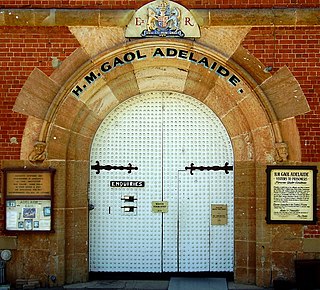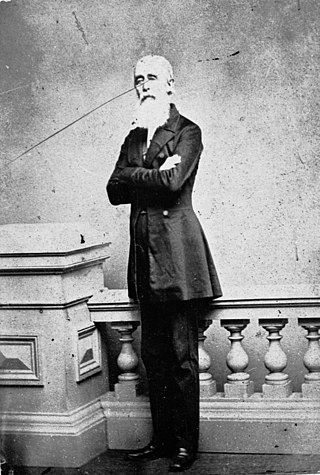
South Australia is a state in the southern central part of Australia. It covers some of the most arid parts of the country. With a total land area of 984,321 square kilometres (380,048 sq mi), it is the fourth-largest of Australia's states and territories by area, and second smallest state by population. It has a total of 1.8 million people. Its population is the second most highly centralised in Australia, after Western Australia, with more than 77 percent of South Australians living in the capital Adelaide, or its environs. Other population centres in the state are relatively small; Mount Gambier, the second-largest centre, has a population of 33,233.

William Light, also known as Colonel Light, was a British-Malayan naval and army officer. He was the first Surveyor-General of the new British Province of South Australia, known for choosing the site of the colony's capital, Adelaide, and for designing the layout of its streets, six city squares, gardens and the figure-eight Adelaide Park Lands, in a plan later sometimes referred to as Light's Vision.
The Kaurna people are a group of Aboriginal people whose traditional lands include the Adelaide Plains of South Australia. They were known as the Adelaide tribe by the early settlers. Kaurna culture and language were almost completely destroyed within a few decades of the British colonisation of South Australia in 1836. However, extensive documentation by early missionaries and other researchers has enabled a modern revival of both language and culture. The phrase Kaurna meyunna means "Kaurna people".

South Australia Police (SAPOL) is the police force of the Australian state of South Australia. SAPOL is an independent statutory agency of the Government of South Australia directed by the Commissioner of Police, who reports to the Minister for Police. SAPOL provides general duties policing, highway patrol, criminal investigation and emergency coordination services throughout the state. SAPOL is also responsible for road safety advocacy and education, and maintains the South Australian Road Safety Centre.

Adelaide Gaol is a former Australian prison located in the Park Lands of Adelaide, in the state of South Australia. The gaol was the first permanent one in South Australia and operated from 1841 until 1988. The Gaol is one of the two oldest buildings still standing in South Australia, the other being Government House which was built at the same time. The prison is now a museum, tourist attraction and function centre.

Sir Robert Richard Torrens,, also known as Robert Richard Chute Torrens, was an Irish-born parliamentarian, writer, and land reformer. After a move to London in 1836, he became prominent in the early years of the Colony of South Australia, emigrating after being appointed to a civil service position there in 1840. He was Colonial Treasurer and Registrar-General from 1852 to 1857 and then the third Premier of South Australia for a single month in September 1857.

This article details the History of Adelaide from the first human activity in the region to the 20th century. Adelaide is a planned city founded in 1836 and the capital of South Australia.

Special Tasks and Rescue Group is the Police Tactical Group of the South Australia Police.

Eudunda is a rural town in South Australia, roughly 103 kilometres northeast of Adelaide, established in 1870 after settlers began moving into the area in the 1860s. As of the 2006 census, Eudunda had a population of 640.

Thomas Shuldham O'Halloran was the first Police Commissioner and first Police Magistrate of South Australia.

Sir James Hurtle Fisher was a lawyer and prominent South Australian pioneer. He was the first Resident Commissioner of the colony of South Australia, the first Mayor of Adelaide and the first resident South Australian to be knighted.
John Lee Archer was the Civil Engineer and Colonial Architect in Van Diemen's Land, serving from 1827 to 1838. During his tenure, Archer was responsible for all Tasmanian government buildings including those for penal and military purposes.

Australian native police units, consisting of Aboriginal troopers under the command (usually) of at least one white officer, existed in various forms in all Australian mainland colonies during the nineteenth and, in some cases, into the twentieth centuries. The Native Mounted Police utilised horses as their transportation mode in the days before motor cars, and patrolled huge geographic areas. The introduction of a Police presence helped provide law & order to areas which were already struggling with crime issues. From established base camps they patrolled vast areas to investigate law breaches, including alleged murders. Often armed with rifles, carbines and swords, they sometimes also escorted surveying groups, pastoralists and prospectors through country considered to be dangerous.

Raymond Wells Whitrod, was an Australian police officer and criminologist. He was considered a world leader in the way society treats victims of crime. He was known as a man of high professional standards, with a commitment to justice, equity and integrity. He became best known for his term as Commissioner of the Queensland Police Service, resigning in protest in 1976 at the corruption then endemic in Queensland, and in particular over the appointment by the Premier of Queensland, Joh Bjelke-Petersen, of Terry Lewis as Assistant Commissioner.

Henry Inman (1816–1895) was an English cavalry officer, pioneer of South Australia, founder and first commander of the South Australia Police, overlander and Anglican clergyman.
The Society for Underwater Historical Research (SUHR) was an amateur maritime archaeology organisation operating in South Australia (SA). It was formed in 1974 by recreational scuba divers and other persons to pursue an interest in maritime archaeology and maritime history. The SUHR was renamed as the South Australian Archaeology Society in March 2012 as part of a plan to expand its activities beyond maritime archaeology to include other archaeological disciplines.

The New South Wales Mounted Police Unit is a mounted section of the New South Wales Police Force. Founded by Governor Thomas Brisbane, on 7 September 1825, the Mounted Police were recruited from a British military regiment stationed in NSW at the time, to protect travellers, suppress convict escapees and fight Indigenous Australians. The force remained the mounted division of the British Army in the colony of New South Wales until 1850, when it took upon a more civilian role. The NSW Mounted Police Unit is the oldest continuous mounted group in the world.
Crime in South Australia is prevented by the South Australia Police (SAPOL), various state and federal courts in the criminal justice system and the state Department for Correctional Services, which administers the prisons and remand centre.
Henry Alford was a police trooper in colonial South Australia, the colony's first mounted constable. He left the force at a time of low morale and became a hotel owner and publican, in which pursuit he was followed by his two sons.

The Security Response Section (SRS) is a unit of the South Australia Police, deployed to “at-risk” crowded places such as large protests and AFL games, and to conduct regular patrols of Rundle Mall, the Adelaide Railway Station and the Adelaide Central Market. The SRS is a second-tier response between general duties and Special Tasks and Rescue. Unlike regular police officers, the unit has enhanced tactical skills and operational equipment including combat helmets, ballistic vests and long-arm weapons such as semi-automatic rifles. The unit is claimed to “significantly bolster public safety”.















